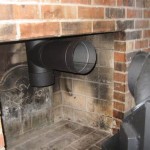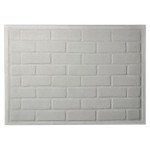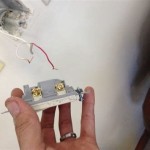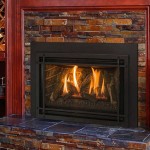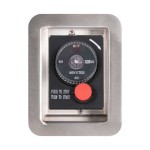How To Clean Fireplace Brick From Smoke
Fireplaces, a traditional focal point in many homes, provide warmth and ambiance, especially during colder months. Regular use, however, inevitably leads to the accumulation of soot, creosote, and smoke stains on the brickwork. These unsightly deposits not only detract from the fireplace's aesthetic appeal but can also pose a fire hazard. Proper cleaning and maintenance are crucial to ensure the fireplace remains both beautiful and safe to use. This article outlines a comprehensive guide to effectively clean fireplace brick from smoke and soot, detailing the necessary steps, materials, and precautions.
Before commencing any cleaning procedure, it is imperative to prioritize safety. Wearing appropriate protective gear is essential to prevent skin and respiratory irritation. This includes wearing gloves, safety glasses, and a dust mask or respirator. Ensuring adequate ventilation in the work area is also critical; opening windows and doors or using a fan can help to disperse airborne particles and fumes. If dealing with significant creosote buildup, consulting with a professional chimney sweep is advisable, as creosote is highly flammable and requires specialized removal techniques. Failing to take these precautions can lead to health issues and potential injury.
Preparation is Key: Gathering Supplies and Protecting Surroundings
Effective fireplace brick cleaning requires a strategic approach. The initial step involves gathering all the necessary cleaning supplies and preparing the surrounding area. This preparatory phase is crucial for ensuring a smooth and efficient cleaning process. The required materials typically include:
- A stiff-bristled brush (a wire brush may be needed for stubborn stains)
- A vacuum cleaner with a hose attachment
- A spray bottle
- Cleaning solutions (options include trisodium phosphate (TSP), commercial fireplace cleaner, vinegar solution, or baking soda paste)
- A bucket
- Sponges or cloths
- Protective gloves
- Safety glasses
- A dust mask or respirator
- Drop cloths or plastic sheeting
Once the materials are assembled, the next step is to protect the surrounding area from potential spills and splatters. Laying down drop cloths or plastic sheeting around the fireplace hearth and on the floor is recommended. This will prevent cleaning solutions and dislodged soot from staining or damaging nearby surfaces. Securing the drop cloths with painter's tape can help prevent them from shifting during the cleaning process. Additionally, removing any nearby furniture or decorations that could be susceptible to damage is advisable. A well-prepared workspace minimizes the risk of accidental damage and streamlines the cleaning process.
Before applying any cleaning solutions, it is essential to remove loose debris from the brick surface. Using the stiff-bristled brush, thoroughly scrub the bricks to dislodge loose soot, ash, and creosote. Pay particular attention to crevices and textured areas where debris tends to accumulate. Following the brushing, use the vacuum cleaner with the hose attachment to remove the dislodged particles. This step is critical for preventing the soot from being spread around or incorporated into the cleaning solution, which could hinder the cleaning process.
Choosing and Applying Cleaning Solutions
Selecting the appropriate cleaning solution is crucial for effectively removing smoke stains and soot from fireplace brick. Several options are available, each with its own advantages and disadvantages. The choice of solution often depends on the severity of the staining and the type of brick. It is always recommended to test the chosen solution on a small, inconspicuous area of the brick before applying it to the entire surface to ensure it does not cause discoloration or damage.
One commonly used cleaning solution is trisodium phosphate (TSP). TSP is a powerful degreaser and cleaner, effective at removing stubborn soot and creosote stains. However, it is a harsh chemical and should be handled with caution. When using TSP, it is essential to wear gloves, safety glasses, and a respirator to protect against skin and respiratory irritation. TSP is typically mixed with water according to the manufacturer's instructions and applied to the brick surface using a sponge or brush. After application, allow the solution to sit for a few minutes before scrubbing the brick. Rinse thoroughly with clean water to remove any residue.
Commercial fireplace cleaners are another option, often formulated specifically for removing soot and creosote from fireplace brick. These cleaners are generally less harsh than TSP but may still require careful handling. Always follow the manufacturer's instructions for application and safety precautions. Many commercial fireplace cleaners come in spray bottles, making them easy to apply to the brick surface. After application, allow the cleaner to sit for the recommended time before scrubbing and rinsing.
For a more environmentally friendly approach, vinegar solutions can be effective for cleaning fireplace brick. White vinegar is a natural cleaner and deodorizer, effective at removing mild smoke stains. A solution of equal parts white vinegar and water can be sprayed onto the brick surface and allowed to sit for a few minutes before scrubbing. Vinegar solutions are generally safe to use but may not be as effective for removing heavy soot deposits. Baking soda paste is another natural cleaning option. Mixing baking soda with water to form a thick paste and applying it to the brick can help to absorb soot and stains. Allow the paste to dry completely before scrubbing and rinsing.
When applying any cleaning solution, it is important to work in small sections, focusing on one area at a time. This prevents the solution from drying out before it can be scrubbed and rinsed. Applying the solution evenly and thoroughly ensures that all areas of the brick receive adequate cleaning. Avoid saturating the brick, as excessive moisture can lead to water damage or efflorescence. Using a spray bottle or sponge for application helps to control the amount of solution used.
Scrubbing, Rinsing, and Drying
After applying the cleaning solution and allowing it to sit for the appropriate amount of time, the next step is to scrub the brick surface. This is where the stiff-bristled brush comes into play. Use firm, circular motions to scrub the brick, paying attention to areas with heavy soot deposits. For stubborn stains, a wire brush may be necessary, but use caution when using a wire brush, as it can scratch the brick surface. Applying consistent pressure and overlapping strokes ensures that all areas are thoroughly cleaned.
Rinsing the brick after scrubbing is essential for removing any remaining cleaning solution and dislodged soot. Use clean water and a sponge or cloth to thoroughly rinse the brick surface. Ensure that all traces of the cleaning solution are removed, as any residue can attract dirt and grime. Rinsing multiple times may be necessary to achieve a clean surface. Using a garden hose with a gentle spray nozzle can be helpful for rinsing large areas, but avoid using high pressure, as it can damage the brick or force water into the mortar joints.
After rinsing, allow the brick to dry completely. This can be achieved by opening windows and doors to promote air circulation or using a fan to speed up the drying process. Avoid using heat guns or hair dryers, as excessive heat can damage the brick. The drying time will depend on the humidity and temperature, but it is generally recommended to allow the brick to dry for at least 24 hours. Inspecting the brick after it has dried will reveal any remaining stains or areas that require further cleaning. If necessary, repeat the cleaning process on those specific areas.
Once the brick is completely dry, consider applying a sealant to protect it from future stains and damage. Brick sealants are designed to penetrate the brick and create a barrier against moisture, soot, and other contaminants. Applying a sealant can extend the life of the brick and make future cleaning easier. Follow the manufacturer's instructions for application, ensuring that the sealant is applied evenly and thoroughly. Regular maintenance, such as wiping down the brick with a damp cloth, can also help to prevent the buildup of soot and stains.
By following these comprehensive steps, fireplace brick can be effectively cleaned and restored to its original appearance. Prioritizing safety, using appropriate cleaning solutions, and employing proper cleaning techniques are essential for achieving optimal results. Regular cleaning and maintenance will not only enhance the aesthetic appeal of the fireplace but also ensure its safe and efficient operation for years to come.

How To Clean Fireplace Bricks Simple Practical Beautiful

How Fo I Remove Fireplace Soot Smoke Hometalk

How To Clean A Fireplace Diy Basics

How To Clean Fireplace Bricks 9 Steps With S Wikihow

4 Ways To Clean Soot From Brick Wikihow

How To Clean Soot Off Brick Fireplaces Anew

How To Clean A Brick Fireplace The Family Handyman

4 Ways To Clean Soot From Brick Wikihow

Remove Soot From Fireplace Tips For Cleaning Chimney

Vane Cottage Chemical Brick Mortar Soot Cleaner 6
Related Posts


